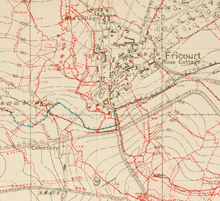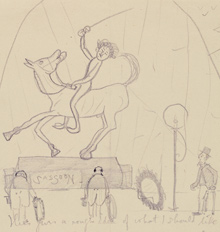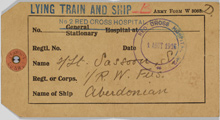Hell Let Loose: The Somme

Trench map showing the sector occupied by Sassoon’s battalion during the first day on the Somme. Sassoon was in a dug-out at the junction of the trenches called Sandown Avenue and Kingston Road, near the bottom left-hand corner of this image. The village of Fricourt was on the German side of the front line. Maps.23.03, 62D NE.2, corrected to 15 June 1916.
… all their hope & merriment snuffed out for ever, and their voices fading on the winds of thought, from memory to memory, from hour to hour, until they are no more to be recalled.
Diary entry, 13 July 1916
The Battle of the Somme was the major British offensive of 1916. In tandem with French forces to the south, the British attacked along an eighteen-mile front, expecting to break through German defences shattered by a week-long artillery barrage. To a greater extent than any other British campaign, the Somme has come to represent the ineffectiveness, incompetence, and ruinous wastage of life which characterized trench warfare. Almost twenty thousand British soldiers were killed on the first day.
Sassoon’s battalion fought in and around Mametz Wood. Sassoon distinguished himself by a single-handed attack on a German position in an attempt to dislodge a sniper: ‘I chucked four Mill’s [bombs] into their trench & to my surprise 50 or 60 ran away like hell’; but his unit could not consolidate the advantage. Sassoon’s friend and fellow-poet, the ‘whimsical & queer & human’ Robert Graves, was fighting in another battalion of the Royal Welch Fusiliers nearby. On 21 July Sassoon received news that Graves had died of wounds.

Detail from Sassoon’s sketch of the memorial he wanted erected to him on Market Hill, Cambridge ‘after my demise’, July 1916. MS Add. 7973/S25a.

